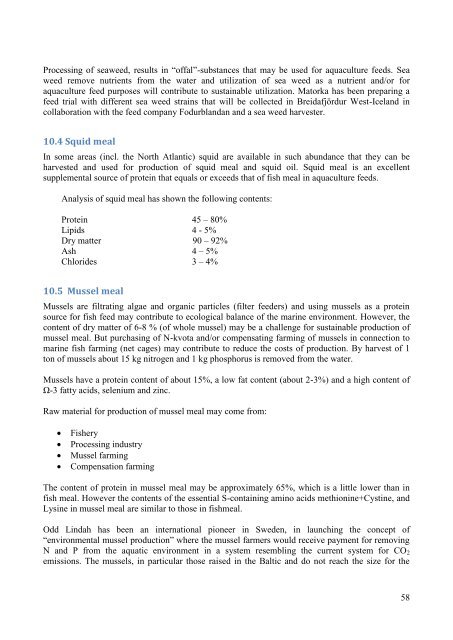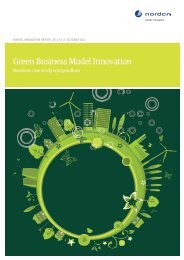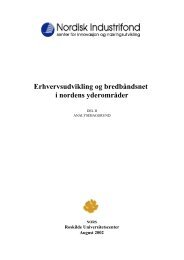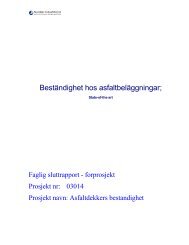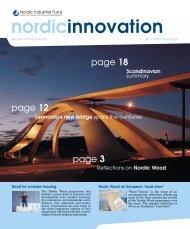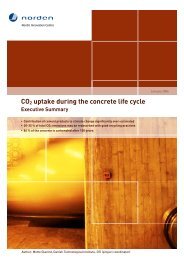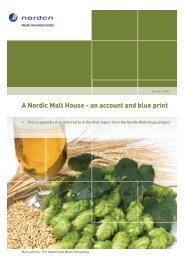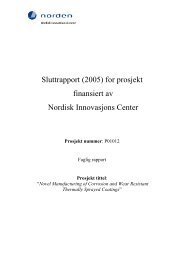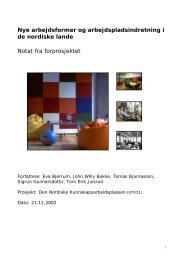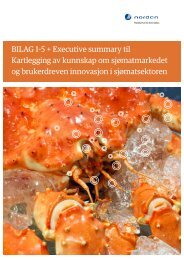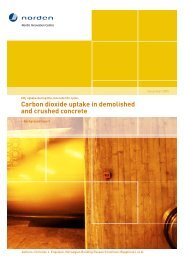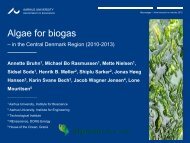Local raw materials for production of fish feed for ... - Nordic Innovation
Local raw materials for production of fish feed for ... - Nordic Innovation
Local raw materials for production of fish feed for ... - Nordic Innovation
Create successful ePaper yourself
Turn your PDF publications into a flip-book with our unique Google optimized e-Paper software.
Processing <strong>of</strong> seaweed, results in “<strong>of</strong>fal”-substances that may be used <strong>for</strong> aquaculture <strong>feed</strong>s. Sea<br />
weed remove nutrients from the water and utilization <strong>of</strong> sea weed as a nutrient and/or <strong>for</strong><br />
aquaculture <strong>feed</strong> purposes will contribute to sustainable utilization. Matorka has been preparing a<br />
<strong>feed</strong> trial with different sea weed strains that will be collected in Breidafjördur West-Iceland in<br />
collaboration with the <strong>feed</strong> company Fodurblandan and a sea weed harvester.<br />
10.4 Squid meal<br />
In some areas (incl. the North Atlantic) squid are available in such abundance that they can be<br />
harvested and used <strong>for</strong> <strong>production</strong> <strong>of</strong> squid meal and squid oil. Squid meal is an excellent<br />
supplemental source <strong>of</strong> protein that equals or exceeds that <strong>of</strong> <strong>fish</strong> meal in aquaculture <strong>feed</strong>s.<br />
Analysis <strong>of</strong> squid meal has shown the following contents:<br />
Protein 45 – 80%<br />
Lipids 4 - 5%<br />
Dry matter 90 – 92%<br />
Ash 4 – 5%<br />
Chlorides 3 – 4%<br />
10.5 Mussel meal<br />
Mussels are filtrating algae and organic particles (filter <strong>feed</strong>ers) and using mussels as a protein<br />
source <strong>for</strong> <strong>fish</strong> <strong>feed</strong> may contribute to ecological balance <strong>of</strong> the marine environment. However, the<br />
content <strong>of</strong> dry matter <strong>of</strong> 6-8 % (<strong>of</strong> whole mussel) may be a challenge <strong>for</strong> sustainable <strong>production</strong> <strong>of</strong><br />
mussel meal. But purchasing <strong>of</strong> N-kvota and/or compensating farming <strong>of</strong> mussels in connection to<br />
marine <strong>fish</strong> farming (net cages) may contribute to reduce the costs <strong>of</strong> <strong>production</strong>. By harvest <strong>of</strong> 1<br />
ton <strong>of</strong> mussels about 15 kg nitrogen and 1 kg phosphorus is removed from the water.<br />
Mussels have a protein content <strong>of</strong> about 15%, a low fat content (about 2-3%) and a high content <strong>of</strong><br />
Ω-3 fatty acids, selenium and zinc.<br />
Raw material <strong>for</strong> <strong>production</strong> <strong>of</strong> mussel meal may come from:<br />
Fishery<br />
Processing industry<br />
Mussel farming<br />
Compensation farming<br />
The content <strong>of</strong> protein in mussel meal may be approximately 65%, which is a little lower than in<br />
<strong>fish</strong> meal. However the contents <strong>of</strong> the essential S-containing amino acids methionine+Cystine, and<br />
Lysine in mussel meal are similar to those in <strong>fish</strong>meal.<br />
Odd Lindah has been an international pioneer in Sweden, in launching the concept <strong>of</strong><br />
“environmental mussel <strong>production</strong>” where the mussel farmers would receive payment <strong>for</strong> removing<br />
N and P from the aquatic environment in a system resembling the current system <strong>for</strong> CO2<br />
emissions. The mussels, in particular those raised in the Baltic and do not reach the size <strong>for</strong> the<br />
58


